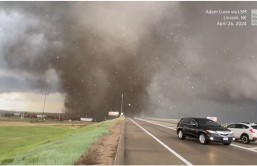Hurricane Matthew hits Florida coastline on Friday. As the western eye of the storm heads toward Cape Canaveral, NASA's Kennedy Space Center has ceased its operation.
Although Hurricane Matthew did not make a landfall in Florida, but its force is devastating. The eye of the storm is now moving toward Cape Canaveral. The storm delivered winds at the speed of 120 mph, and high storm surges to Central Florida on Friday.
"It could have been a lot worse," National Hurricane Service's Matt Volkmer told Orlando Sentinel.
"The issue right now is the outer wall diameter is just wide enough that we're going to see it move up Kennedy Space Center, Cape Canaveral and the barrier islands of Volusia county."
The Kennedy Space Center braced for the Hurricane Matthew as CBS News reported. The critical facilities at the NASA Space Center and Cape Canaveral Air Force Station including the launch pads have prepared for the onslaught of the storm.
Hurricane Matthew is the Category 4 storm, and recorded as the strongest hurricane ever threatened the U.S. in decades.
Previously, Category 5 Hurricane David in 1979 moved off shore in the similar track hitting Savannah, Georgia as Category 2 hurricane. But it didn't have the potential to create damage as Matthew does, which forced over two million people to evacuate, as reported by Washington Post.
As the storm approaches, the Kennedy Space Center went into HURCON 1 status on Thursday, which means an imminent risk of hurricane. All the protocols to prepare for hurricane were executed and completed on the same day, according to NASA spokesman George Diller.
A team of 139 members will be a ride out team that is stationed at various facilities across the space center to monitor critical systems and report any significant events. The team is reporting to the emergency operation personnel, who worked in the command center at Complex 39 Launch Control Center.








